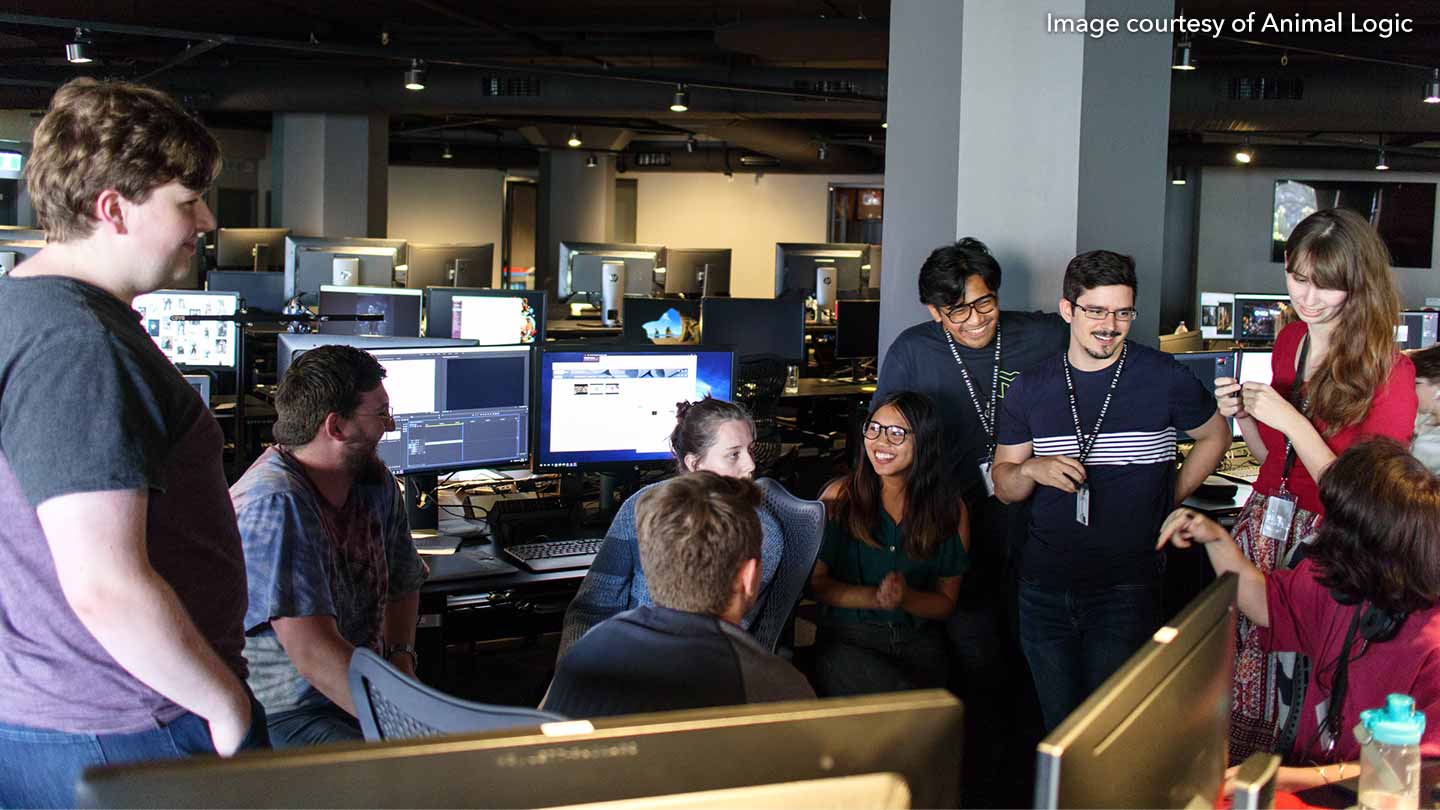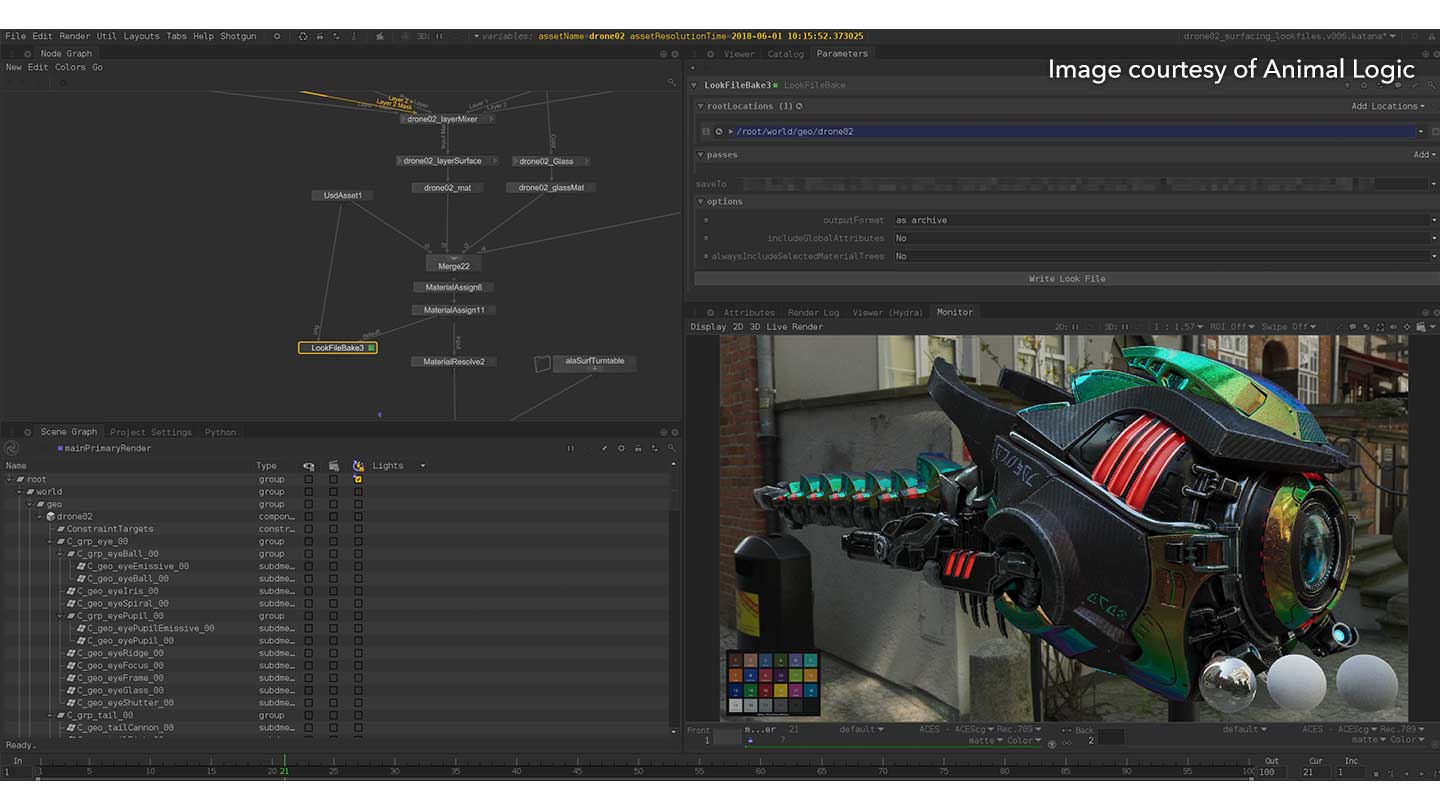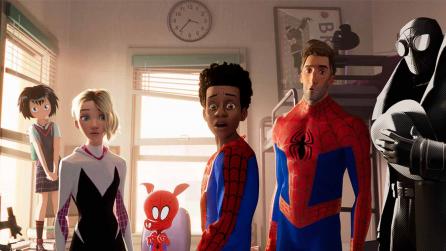Animal Logic Academy: discovering the VFX stars of the future
How ALA is preparing budding artists for the future with Katana
Recognized as one of the world’s leading independent creative digital studios, Animal Logic has been producing award winning design, visual effects and animation for over 25 years.
The studio is also committed to discovering and championing the best new talent in the industry, and it’s in that spirit that the Animal Logic Academy was set up.
A partnership between Animal Logic and the University of Technology, Sydney (UTS), the Animal Logic Academy (ALA) sees Masters students take part in ambitious group projects lead by industry mentors.
Their first project of 2018 - a short animation called The Colour Thief, about a hero who returns color to a grey world - saw the team adopt Katana as the lighting and look development package for the first time.

We caught up with some of the staff and students involved to find out how it went.
Surfacing with templates and macros
Daniel Flood is the Technical Lead at ALA. With a wealth of professional experience working as a VFX artist and coder, he mentored students on the project along with other staff leads, supervising across surfacing, lighting, and software development.
“This was a significant project for us in that it was our first using Katana, USD, and Renderman, as well as having quite an ambitious number of assets to work through”, he says.
Daniel was already familiar with Katana having previously worked as a lighting pipeline TD at Iloura Sydney, and had very positive associations with it.
“The stability is incredible. If something goes wrong with a live render, the main GUI stays responsive. The whole system of a dynamically resolved scene graph is something no other DCC offers, which brings a lot of power in terms of workflow”, he explains.

For surfacing, the team used Katana for creating shader networks for Renderman, preview and turntable renders, and publishing surfacing work, which was published as lookfiles. The team harnessed Katana’s ability to make template projects, making all this easy to deploy.
They also made heavy use of macros to encapsulate functionality and expose the necessary parameters. This provided a simplified user interface for the students, which enabled them to get to grips with the software faster: “Lighting and surfacing with Katana really lend themselves to templates and macros, which are a great way to achieve consistency across shots and assets”, Daniel says.
“Complexity can be hidden in macros, but students can also dive inside them to see how it all works.”
Ailisha Sabalburo, one of the students who took the role of surfacing lead on the project, agrees: “Being able to set up a template for lookdev and then just update the textures allowed me to quickly render out multiple assets in a short amount of time. It allowed me to spend more time being creative and less time solving problems.”

A central theme of the project is the trail of color the hero leaves as she runs through the city. The concept is that as she passes, color returns to the world, and to achieve this the team needed to make two texture variants for each asset: one in drab grey colours, one in a cheerful and highly saturated colour scheme.
To make the concept work, they used lookfile passes in Katana: the primary texture variant of drab grey was the default pass, and the highly saturated textures were published as a secondary highSat pass.
The drab grey lookfile pass was used in the primary render, and the secondary colorful pass was rendered during the data AOV pass as an albedo AOV, allowing the two to be mixed in Nuke.
Ailisha notes that this created a huge set of assets - over 180 in all - which had the potential to be challenging to manage. Fortunately, Katana made it easy: “Katana’s node-graph workflow really helped organize these two versions of exported maps. Being able to place a Variable set and switch within Katana allowed us to swap between the two versions quickly and efficiently.”
Lighting with USD
For lighting, the team used Pixar’s Universal Scene Description (USD) to efficiently build scenes, as well as a Katana plugin developed by students and staff for automatic lookfile assignments. This essentially enabled them to bring in a whole shot with just two nodes - one for the shot USD and one for their auto lookfile assigner.
Staff and students implemented a system for encoding published assets as URIs rather than absolute file paths, which is a core concept of Katana’s asset management plugins.
This allowed them to reference assets without hard-coding a particular version, so updates could dynamically flow through into the scene graph.

For example, their USD documents included metadata to store lookfile URI information on asset locations. Their Katana plugin for automated lookfile assignment checked for the presence of this metadata in the scene graph attributes, and if found, passed it to their URI resolver which returned the latest lookfile path, which was then set as a scene graph attribute. They used a similar solution for USD referencing, so that by default the latest published assets was loaded.
As Daniel explains: “We were early adopters of Katana 3 and we quickly integrated it into our production, finding the new Hydra viewport to be a huge bonus in terms of quickly loading and exploring large sets.
We’ve had an incredibly positive experience using and also developing for Katana in a University context, in terms of stability, scalability and ease of adoption.“
Picking up Katana from scratch
Emma Cooney is a previous graduate of the ALA masters course, and on The Colour Thief project she took a supervisory role as the look development TD.
Her primary task was to assist Technical Lead Daniel Flood with the setup of the look development pipeline, focusing in particular on the workflow between Substance Painter and Katana for surfacing. She also assisted in setting up the lighting template within Katana, documenting the studio workflow for students, and creating macros for student use.
“I came into my job with no experience of Katana, and found it extremely straightforward to pick up the basic workflow”, she says.

“Most of the students who had no experience with either Katana or Nuke were able to pick up the basic workflow of both very quickly, thanks to the academy's use of lighting and surfacing templates, as well as in-studio documentation.”
Alexis O’Connor, lighting lead on the project, was one such student: “I think I've been using Katana for approximately three months, and there was a lot to wrap my head around at first - but it was all easy to digest and I got a good basic grasp of it quickly”,
Chana Corna, animation lead and lighter on the project, wanted to get a better understanding of what goes into making an animated short film.
“Being a part of the project has been great, in that I've learned so much as part of the animation and lighting departments - way more than I expected to”, she says.
“Having that hands-on experience has really helped me develop new skills as a professional”.
She explains that she found Katana a breath of fresh air: “Using Katana has been pretty amazing. The ability to prune out geometry and test renders makes it way easier to test out small changes”.
These are sentiments echoed by project artist Jemima Blackman, who was hoping to learn a faster and easier way of lighting: “I very much prefer the clean workflow of Katana and its nodes”, she says.
Samantha Chui, lighting artist on the project, agrees: “Katana has many tools that I can use to achieve different effects.”
Preparing for a node-based future
A great number of the students share an appreciation for the power and flexibility of using a node-based workflow since using Katana.
“Although the nodes are different, there are so many tutorials out there that can help you understand what they do, and Foundry even has a database to explain everything”, says Jemima.
Miriam Bowie-Johnson echoes this: “The 'I want a pony' help node was a good way to learn the basics of how to lay out nodes and which ones you need for a scene and render.
I think learning any program which uses the node-based system and being able to understand that will stand me in good stead when learning other programs in the future”.
Daniel Flood offers a final word of advice to budding look development and lighting artists in the process of choosing which software to learn: “Pick a lighting toolset that lets you focus on lighting, is widely used in industry, is stable and reliable, and offers a bridge to more technical work such as linking parameters - and which provides some entry to automation through macros/gizmos.”
Want to experience the power of Katana for yourself? Get a free 30-day trial here.


